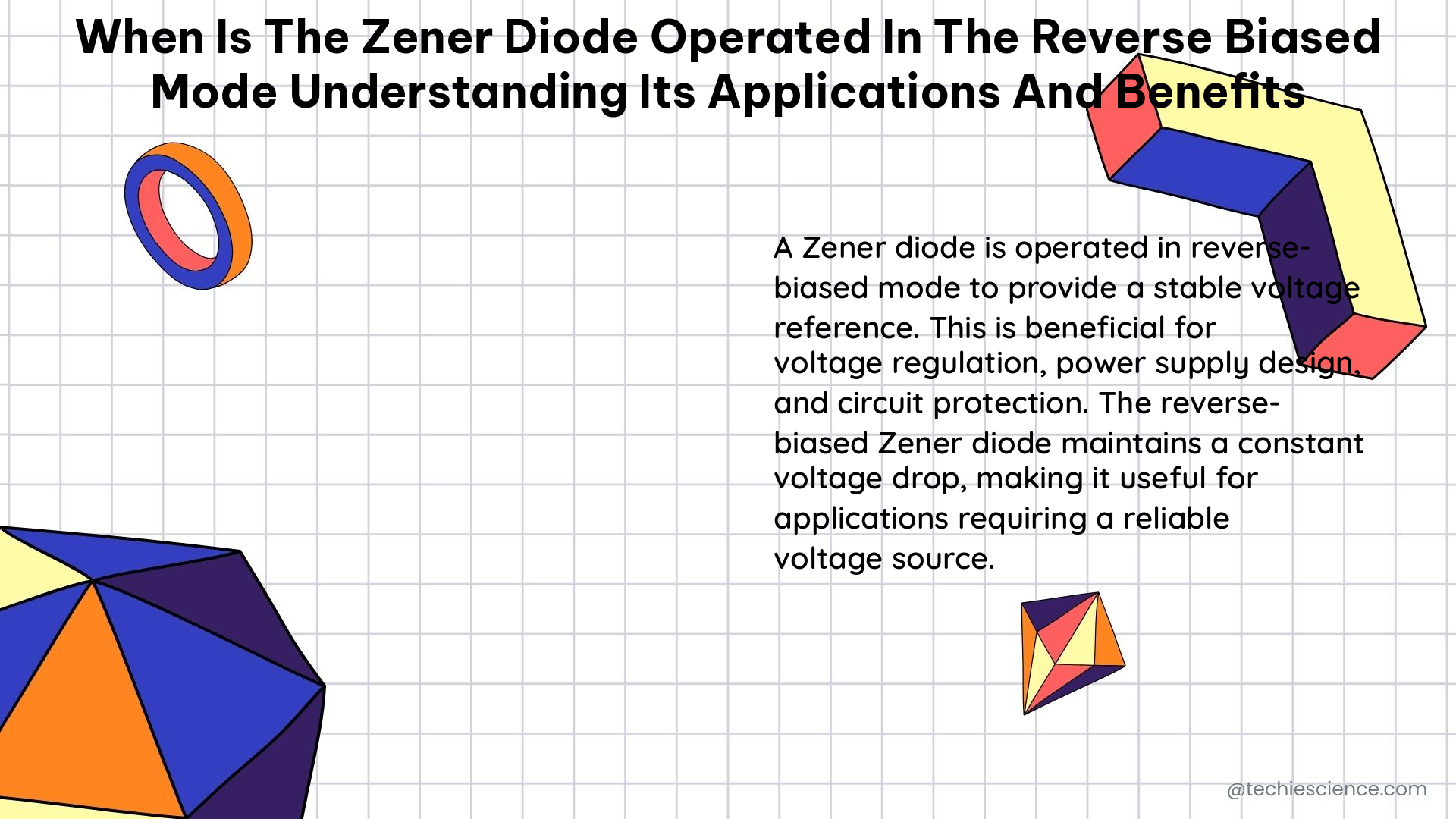Zener diodes are specialized semiconductor devices that are designed to operate in the reverse bias mode, making them a crucial component in various electronic circuits. When a voltage is applied in the reverse direction and reaches the Zener voltage (also known as the knee voltage), the junction experiences a breakdown, allowing current to flow in the opposite direction. This phenomenon, known as the Zener Effect, is the key characteristic that enables Zener diodes to serve a wide range of applications.
Understanding the Reverse Biased Operation of Zener Diodes
Zener diodes have a wide range of Zener voltages (Vz), and some even feature adjustable Zener voltages to achieve variable voltage regulation. These highly doped semiconductor devices have their reverse breakdown voltage (Vz) determined during the manufacturing process. As the reverse voltage across the Zener diode increases from 0 volts to its Zener breakdown voltage, a small reverse or leakage current flows through the diode, which remains relatively constant as the reverse voltage increases.
Once the reverse voltage applied across the Zener diode exceeds the rated voltage of the device, a process called Zener breakdown occurs in the semiconductor depletion layer. This triggers a current to start flowing through the diode, limiting the increase in voltage. The current flowing through the Zener diode now increases dramatically to its maximum circuit value, which is typically limited by a series resistor. Interestingly, the voltage drop across the diode remains fairly constant even as the Zener current increases, making Zener diodes an ideal choice for voltage regulation applications.
Zener Diode Characteristics in Reverse Bias

The V-I (Voltage-Current) characteristics of a Zener diode can be studied under two main categories: Forward Characteristics and Reverse Characteristics.
Forward Characteristics
The forward characteristics of the Zener Diode are similar to the forward characteristics of any standard diode. In the forward bias condition, the Zener diode behaves like a regular diode, with a small forward voltage drop and a relatively high forward current.
Reverse Characteristics
In reverse voltage conditions, a small amount of current flows through the Zener diode due to thermally generated minority carriers. As the reverse voltage increases, at a particular value of reverse voltage, the reverse current increases suddenly at the breakdown point, which is called the Zener voltage (Vz).
The Zener voltage (Vz) typically ranges from 2.4 volts to 200 volts, depending on the specific Zener diode model. The maximum current (Iz) that the diode can achieve at the Zener Voltage is called the max current. The power rating (PZ) denotes the maximum power the Zener diode can dissipate, which is calculated as the product of the voltage of the diode and the current flowing through it.
It is worth noting that the temperature stability of Zener diodes around 5V has the best stability, and the voltage tolerance is typically ±5%.
Applications and Benefits of Zener Diodes in Reverse Bias
Zener diodes are widely used in various electronic applications due to their unique ability to operate in the reverse bias mode. Some of the key applications and benefits of Zener diodes include:
-
Voltage Regulation: Zener diodes are extensively used in voltage regulation circuits to maintain a constant output voltage, even when the input voltage or load conditions fluctuate. The constant voltage drop across the Zener diode, regardless of the current, makes it an ideal choice for voltage regulation.
-
Over-Voltage Protection: Zener diodes can be used to protect sensitive electronic components from sudden voltage spikes or surges by clamping the voltage to a safe level. When the voltage exceeds the Zener voltage, the diode conducts, shunting the excess voltage to ground and preventing damage to the protected circuit.
-
Clipping Circuits: Zener diodes are employed in clipping circuits to limit the amplitude of AC signals, effectively “clipping” the waveform at a predetermined voltage level. This is useful in applications such as audio signal processing, where the signal needs to be confined within a specific voltage range.
-
Biasing Circuits: Zener diodes can be used to provide a stable reference voltage for biasing transistors and other semiconductor devices, ensuring consistent and reliable operation.
-
Transient Suppression: Zener diodes can be used to suppress transient voltage spikes, which can occur in power supply lines or other circuits due to inductive loads or sudden changes in the power supply. By clamping the voltage to a safe level, Zener diodes protect sensitive components from damage.
-
Adjustable Voltage Regulation: Some Zener diodes feature adjustable Zener voltages, allowing for variable voltage regulation in circuits. This flexibility is particularly useful in applications where the required voltage needs to be fine-tuned or adjusted.
-
Temperature Compensation: Zener diodes with a low temperature coefficient can be used to provide temperature-compensated voltage references, ensuring stable operation across a wide range of temperatures.
-
Pulse Shaping: Zener diodes can be employed in pulse shaping circuits to convert irregular or distorted pulses into clean, well-defined square waves, which is essential in digital logic circuits and timing applications.
By understanding the reverse biased operation of Zener diodes and their various applications, electronics engineers and designers can leverage these versatile semiconductor devices to create robust, reliable, and efficient electronic circuits across a wide range of industries and applications.
Reference:

The lambdageeks.com Core SME Team is a group of experienced subject matter experts from diverse scientific and technical fields including Physics, Chemistry, Technology,Electronics & Electrical Engineering, Automotive, Mechanical Engineering. Our team collaborates to create high-quality, well-researched articles on a wide range of science and technology topics for the lambdageeks.com website.
All Our Senior SME are having more than 7 Years of experience in the respective fields . They are either Working Industry Professionals or assocaited With different Universities. Refer Our Authors Page to get to know About our Core SMEs.